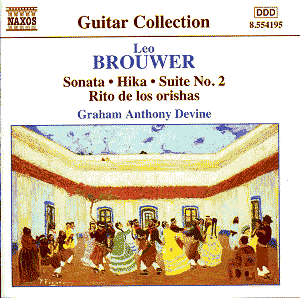Right from the first note you know this is not
your ordinary guitar disk. It’s a harmonic played at a strength
and pitch you’ve never heard before. The guitar sound is beautiful
throughout and both composer and performer must share the credit
for this.
The music is ultra-modern, but not twelve-tone,
not post-romantic, and not minimalistic. The compositions are
ingenious and fascinating, defying any easy classification into
style, but several characteristics can be pointed out. With the
conspicuous exception of the final number, Un Dia de Noviembre,
there is no beat, no steady rhythm. The works are reflective,
improvisatory, made up of fragments of tunes, short rhythmic episodes,
and sensual long-held chords. Even those numbers with dance titles
do not have a beat. No texture is maintained for long, leading
to constant exploration of sound, harmony, and texture. The music
fits the guitar beautifully, not producing ugly squeaks or slaps
or scrapes that much modern guitar music abounds in. Performer
Devine is completely comfortable with this music technically and
produces beautiful sounds and a minimum of finger noises in spite
of the severe technical demands made upon him by the music. While
the earliest work on this disk, the Suite #2, is the most
classic sounding in style, all the works maintain a remarkable
consistency of personality and style in spite of their eclecticism.
Only a person with very strong traditional tastes and a firm dislike
of modern sound could find fault with this music.
The final number, Un Dia de Noviembre,
does have a tune and a beat; it was written as film music, in
the BBC closing credits musical style, for a black and white film
produced in Cuba by Humberto Solaz in 1967.
The composer is Cuban and first studied with
his father. He seems to have had no difficulty travelling all
over the world to study and concertize. He was a good friend of
Toru Takemitsu and Hika was composed as an elegy for him.
The Sonata was written for Julian Bream. The Latin American
Pieces are hardly typical of other Latin American music except
in their gentle Latin swing and relaxed good humour, particularly
in #1, "Variations on a Piazzola Tango." The Passacaglia
was written for Eli Kassner, Brouwer’s Canadian guitar teacher.
The Rito de los Orishas is descriptive of Afro-Cuban folk
religious rituals; Orisha means god or goddess in the African
Yoruba language. Since 1981 Brouwer has been general director
of the Orquesta Nacional de Cuba. He also teaches at the Conservatorio
Nacional and serves as an advisor to Radio Habana.
For a biography, list of compositions and discography,
you might want to go to:
www.musicweb-international.com/brouwer/brouwer.htm
For a review of Volume 2, go to:
www.musicweb-international.com/classrev/2002/Feb02/Brouwer.htm
Paul Shoemaker
